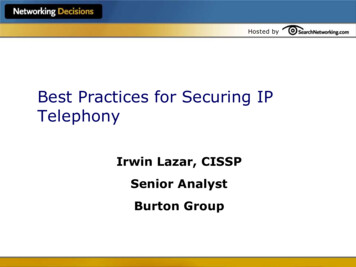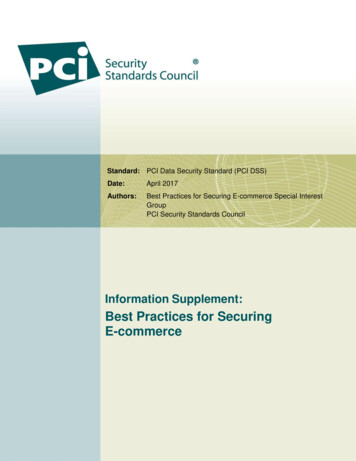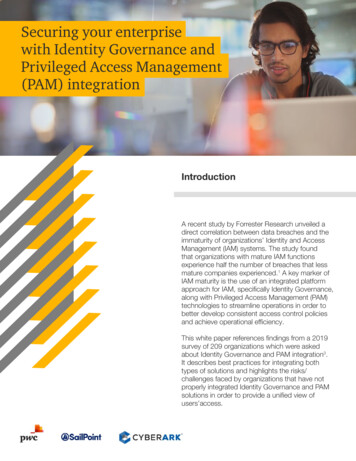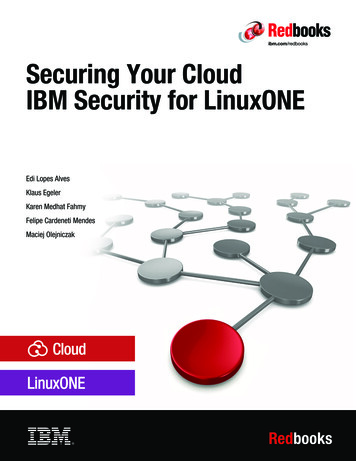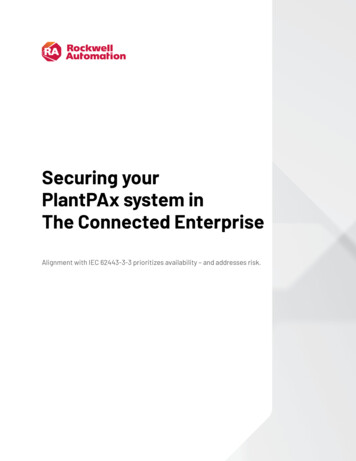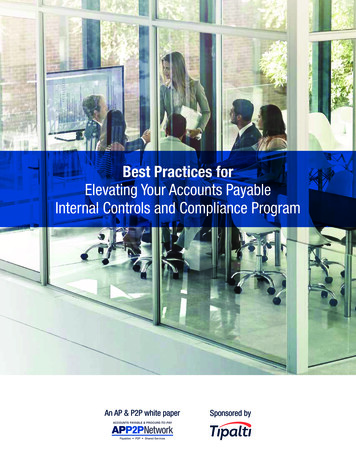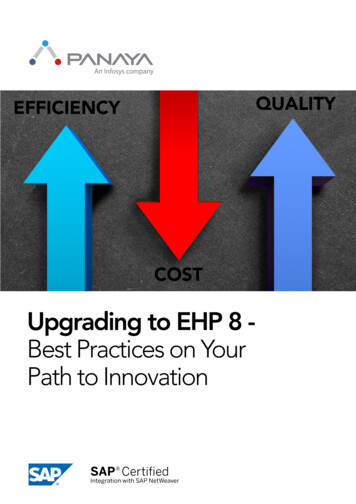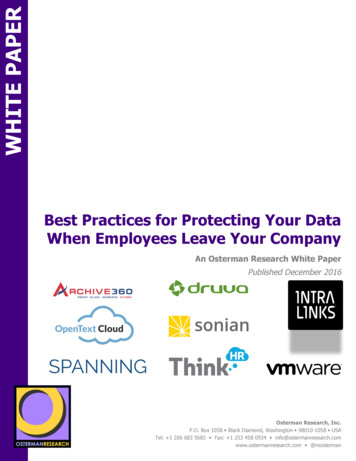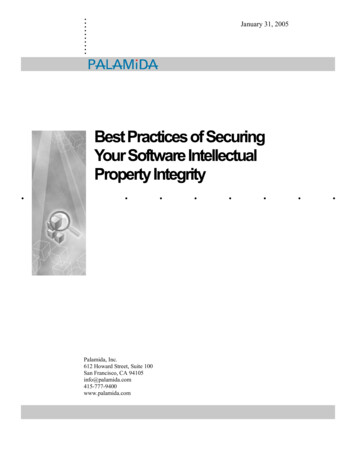
Transcription
.January 31, 2005Best Practices of SecuringYour Software IntellectualProperty Integrity.Palamida, Inc.612 Howard Street, Suite 100San Francisco, CA .
.Intellectual Property IntegrityIntroductionNever before have Best Practices for managing and monitoring intellectual property (IP)licenses for software been more critical. IP licensing woes have ensnared companies asdisparate as IBM, AutoZone, Cisco, DaimlerChrysler, MySQL, Progress Software andCompuware.SCO’s 5 billion IP software infringement suit against IBM represents the most stunninglegal case, but even the smaller MySQL vs. Progress Software lawsuit cost Progress morethan 10 million in legal fees, code redevelopment and product delays.These legal cases reflect a major change in how software is created: Today most software isassembled from pre-existing components, not written from scratch. Third-party componentsprovide tremendous benefits, but they carry significant risks. For most companies, theburgeoning use of third-party components has overwhelmed homegrown, manual systems andbusiness processes for monitoring external components and their licenses.This rapid shift has left many CEOs, legal counsel and IT managers flying blind about thestatus of IP licenses in their applications. Legal oversight is playing catch-up to this revolutionin software development—just as new legal requirements such as Sarbanes-Oxley requirecorporate officers to certify that controls are in place to prevent fraud.Three irreversible trends in IP licensing have turned up the heat on both legal and technologyexecutives:1.2.3.Software components (both open source and commercial) are easily downloadedover high-speed Internet connections. A recent Gartner Group study found that 70%of all new applications contain a mix of homegrown and external softwarecomponents. Why? Tested, proven components boost reliability, add functionalityand significantly cut time to market and development costs.The open source software movement has vastly increased the availability ofcomponents. Thousands of new open source components are released every week,and developers use them. Troublingly, a recent Evans Data Corp. survey revealedthat more than 60% of enterprise-class developers are using open source componentstoday—with or without their managers’ knowledge.The huge growth in outsourced and offshore development requires extra care invalidating IP code status. Contract and offshore developers work cheaper, butcompanies exercise less control over them. More than 300 of the Fortune 500 dobusiness with Indian IT services companies, according to a 2004 Gartner study. Outlaw.com, an IT legal resource, found that almost 70% of responding softwaredevelopers keeps a personal collection of software components that they reuse ondifferent employers’ applications without the legal owner’s knowledge orpermission.The growing use of software components, the natural result of these three trends, raises therisk of IP license infringement. Every software component, open source or commercial,2
comes with a software license that has unique terms and conditions that can significantlyinfluence a product's value, price and distribution.DiscoveryThe legal implications of this new style of software development influence both independentsoftware vendors (ISVs) and in-house developers creating proprietary applications. Considerthese real-world situations that demonstrate how IP licensing issues touch companies today: Prove you’re Clean: A small ISV is trying to sell its software to a Fortune 500company. Because of the perceived risk of buying third-party software, the potentialbuyer demands an audit for possible license violations before signing the contract.Manual code review takes time and often proves unreliable. The small ISV cannotafford to prolong the sales process. Palamida provides the fastest and most reliablesolution to validate “clean” code. Hold that Acquisition: A large networking company is negotiating to acquireanother firm. The buyer’s intellectual property attorney called Palamida for an IPaudit of the seller’s source code before closing the deal. Kill that Litigation: A large software company is being sued by a smaller firm thatclaims its code was poached illegally by the bigger business. The defendant’s legalcounsel has called on Palamida as forensics tool to prove its innocence. Slow that Roll-out: A major corporation is rolling out a new internal application to10,000 desktops. Hours before release, the company discovers that the newapplication includes a commercial component that is free for evaluation but requiresa stiff licensing fee upon redistribution. The company now uses Palamida to avoidsimilar problems in the future. Get Socked by SOX: New mandates in the Sarbanes-Oxley Act require companiesto attest that they have controls in place to prevent fraud, potentially including claimsabout component licenses in their software. Palamida’s solutions give managers theconfidence to certify IP integrity.How To Guarantee Trouble1.Assume someone has already addressed the problem.2.Accept assurances of vendors, employees and contractors without checking.3.Ignore IP license issues in an acquisition.4.Don’t involve Legal. Keep IP license issues within the software group.5.Let Legal handle IP licenses later.6.Audit IP licenses only once a year.3
.Best PracticesWidespread component-based development is relatively new, but Best Practices are beginningto emerge. Specific steps to control IP license issues can be grouped into three phases: GetSet, Get Clean and Stay Clean.In the Get Set phase, companies create a baseline to describe their status today in managing IPlicenses. This first phase has two steps:1.2.The corporate legal and software development organizations jointly review theexisting IP license policy or work together to create a new one.Simultaneously, the company audits its existing code base for all applications toanswer the question, “What do we have today?”In the second or Get Clean phase, activities build on what was learned in phase 1. Stepsinclude:3.4.5.Fix IP license issues uncovered in the audit. This may mean swapping outcomponents with licenses that don’t meet the corporate IP license policy,substituting homegrown code or third-party components with friendlier licenses.Typically, companies begin with development projects currently underway. Butgetting clean extends to older code in existing applications.The Get Clean process involves a lot of back-and-forth discussion between thelegal department and software development organizations. The most aggressivepractitioners investigate how to make these regular communications“privileged” and covered by attorney-client privilege.The third phase, Stay Clean, involves creating conditions and business processes so the effortto Get Clean isn’t wasted. It institutionalizes “clean” practices. To Stay Clean, companiesshould:6.Create a business process to monitor and vet new components as they aredownloaded and before they are incorporated in applications.7. Document and retain records for how new components are introduced.8. Create a culture where compliance is routine. No more private caches of everready but unapproved components.9. Believe assurances, but verify them. The business process to vet newcomponents should include review and oversight by managers or a complianceofficer.10. Stay current with the rapidly evolving world of open source. The environmentchanges daily with new components, new IP licenses, new industry initiatives.In the ongoing Stay Clean phase, Best Practices go into a feedback loop. Auditing the codebase reveals new IP license issues that a corporate IP policy must address. As new kinds oflicenses emerge and new components are introduced, the corporate IP license policy must beadapted. Then the code base needs to be re-audited to comply with the revised IP policy.4
How Palamida HelpsPalamida solutions help companies protect and regain control over their software intellectualproperty (IP) assets. The Palamida IP Amplifier can automate key parts of any Best Practicesroutine to prevent IP license violations. Best Practices also require a corporate IP policy onacceptable licenses for software components, business processes to implement that policy, anda corporate culture that encourages compliance.Palamida’s IP Amplifier automatically detects, assesses and reports on third-partycomponents, both open source and commercial, and their associated IP licenses. IP Amplifierprotects companies against unintentional violations of software licenses and unearthsundesirable IP licenses already in their code base.Used in conjunction with appropriate internal business processes, Palamida solutions mapdirectly to industry Best Practices.In the Get Set phase, companies can audit their applications with Palamida’s software or havePalamida run an audit as a service. But each company must set its own corporate IP policy tocomplete this first phase.In the second or Get Clean phase, companies apply their unique corporate IP license policyand Palamida’s audit to identify and fix problems discovered in the audit.Palamida’s solution makes the Stay Clean phase much easier. Over the life cycle of anapplication Palamida solutions detect, assess and report on new components as they enter thedevelopment environment. Palamida solutions integrate easily with existing development andbusiness processes. Palamida even detects when fragments of a third-party component havebeen improperly added to the code base.As a company works on the “people issues” around business processes and company culture,Palamida automates the task of tracking new components and IP licenses. Through monthlyupdates of Compliance Library, Palamida helps companies stay abreast of the ever-changingworld of open source.Finally, Palamida solutions take the pain out of the continuing feedback loop of finding newlicenses, evolving IP license policy and re-auditing the company’s code base.5
.Key Product Modules for Palamida IP AmplifierComplianceLibraryHolds billions of source code snippets for automatedsource code fingerprinting.Contains millions of source code files of commonly usedopen source components.Contains tens of thousands of the most commonly usedcomponentsCatalogs in-house components.Requires less than 1 gigabyte of disk space.Lists license text, publisher and contact information for allmajor open source licenses.Allows companies to customize metadata informationsuch as software patents, royalty obligations, etc.DetectorModuleUses patent-pending CodeRank to minimize timeconsuming “false positives.”Analyzes binary code, source code, images, icons,archives, XML and text documents for licensing issues.Verifies whether source code is wholly or partially derivedfrom third-party components using patent-pendingCodeRank technology.Lets users share component, license and metadatainformation for a company-wide overview of IP assets andlicensing obligations.What Palamida DeliversPalamida CapabilityCustomer BenefitAudit code base to create baselineinventory of external components,licenses.Establish a system to conduct ongoing IPaudits as the code base evolves.Tracks home-grown and acquiredcomponents.Screen new external components andlicenses before they enter the code base.Keeps executives from “flying blind” about what’sin their software code.Relieves anxiety and liability by providingcontinued confidence of IP integrity.Simplifies monitoring by keeping all IP assets in asingle tool.Creates “Just In Time Compliance” to assure thatIP integrity and corporate reputations are notthreatened.Generates tangible evidence that anti-fraudprocedures are in place, relieving corporateofficers from liability for inadequate controls.Manage external components andlicenses to comply with corporate IPlicense policy.Detect when portions of open source orcommercial components have beenimproperly included in the code base.Conduct ongoing, automated complianceassessments.Provides early warning of IP issues that couldderail a critical development effort.Assures that the investment in achieving IPintegrity is not squandered.6
SummaryToday CEOs, CFOs and General Counsel face new legal requirements to verify that theirinternal controls are in place to prevent fraud. At the same time, software developmentpractices are morphing rapidly. Old procedures and technologies are no longer adequate toverify with certainty that all components in applications carry appropriate licenses.Palamida’s solutions give senior executives the tools to say with confidence that they haveadequately protected their companies (and themselves) against future claims of fraud orcollusion over software IP licenses.In short, Palamida smoothes the path to IP integrity, working alongside key internal businesspractices, to assure senior management they can answer the question, “Who Really OwnsYour Software?”About PalamidaFormed in early 2003, Palamida is an early mover in the software Intellectual Property riskmanagement and compliance market. Our investors include Hummer Winblad, Walden VCand Stanford University. Our customers include Fortune 500, Independent Software Vendorand System Integration companies. Please contact us for more information atwww.palamida.com.7
Palamida automates the task of tracking new components and IP licenses. Through monthly updates of Compliance Library, Palamida helps companies stay abreast of the ever-changing world of open source. Finally, Palamida solutions take the pain out of the continuing feedback loop of finding new
